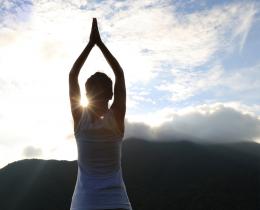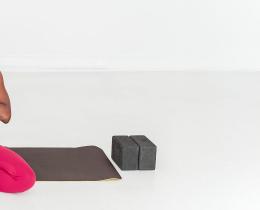Rob: What emotionally motivates you to give back the gift of yoga? What are some standout moments in your teaching?
Jasmine: The emotional connection is partly a heartfelt duty to share the practices that are helpful to me, in case they're helpful to others. But I don't feel like I'm giving back—I'm being given to. I'm so fortunate to share yoga with so many people who helped guide me to a deeper sense of self and the world around me, deconstructing every stereotype or assumption of others' "other-ness."
The emotional connection for yoga service is the human connection. Sharing yoga is another way of saying, "I love you," to total strangers. We're using our bodies to find that common ground and language of love, and nothing is lost in translation. I hear, "I love you back," with every breath I've shared with these students. So by the end of class, something is different. We're no longer strangers. We see that despite any differences, we're just the same. We're all just one decision, or just one situation from being one another. Forget glass half-full or half-empty—we've got a glass, and we're raising it up.
A "wow" moment I treasure is a cop taking off his gun and holster so he could try a headstand (which he landed on the first try, by the way). I've had kids run up to me for hugs after class, and I've had kids run from their yoga mats like they've seen the boogie monster. I've had students yell at me when their medication was off, and I've seen them peacefully cry with joy after the final resting pose in class. The first traumatic brain injury student I taught, taught me that it wasn't about what he couldn't move, but what he could move. The asylum applicants who practiced with me despite facing imminent deportation showed me how to find a home in the self, even when external situations afford us no home. During a class with students transitioning from shelters to subsidized housing, I learned to look my students in the eye.
Don't they say that yoga isn't about yoga—it's about everything else?
Rob: What changes occur during our asana, pranayama, or meditation practices that help us to get off our mats and “give back” to our communities the benefits we’ve received through the practice of yoga?
Jasmine: As the practice of yoga (which includes the ethical restraints and observances, asana, pranayama, sense withdrawal, concentration, meditation, and self-realization) fosters recognition that we all breathe the same, we experience the fact that we are the same. This experience of oneness leads us to a deep sense of compassion, motivating us to share with others the practices that work for us.
When I first started doing yoga I couldn't always contain myself. Sometimes I would cry during class because I had so much emotion bottled up in my body. As I released tension in my body through the practice of yoga, I released it emotionally, too. But there wasn't a particular teacher who made this happen. I made it happen. I did it, using my own flesh, blood, and breath, using asana, pranayama, and meditation as tools. How empowering and liberating is that? How could I not want to share these self-empowering practices with everyone? I already share these practices with students through the five yoga studios I founded, so sharing through yoga outreach programs of Yoga Activist is just another means of sharing. Whether in a studio class, teacher training, or outreach class, I don't give my students anything they don't already have. They have all the power in the universe to let go of their own physical and emotional tension, allowing transformation to unfold. All I'm doing is sharing some down-to-earth (yet totally magical) yoga tools for this process of self-empowerment, self-mastery, self-coping, and self-healing.
Rob: How did you begin to serve?
Jasmine: I taught a class to individuals seeking asylum in the United States. All were survivors of torture and trauma in their previous countries of residence. I didn't really plan the class. It just sort of happened—sort of a call to duty. I knew I had to continue the classes when I saw how basic yoga practices had such an incredible impact on some of the students. It's amazing how just a little yoga can do so much. We don't need fancy sequences or complicated moves—just a loving presence pointing to the present moment, using the body and breath as tools. More of us are capable of this than we might care to admit.
Rob: How can you serve without attachment to the outcome?
Jasmine: All suffering stems from attachment, including attachment to desired outcomes of our action. So I refer to the Bhagavad Gita—we do things because they must be done, offering our actions to the universal awareness that connects us all. When we do things selflessly in this way, it's almost as if we are not acting as individuals at all. It's as if our actions are just part of a harmonious dance with universal law. On a practical level, why do I make my bed if it just gets messed up the next night? Because I must. Why brush my teeth if they are only going to get dirty again anyway? Because I must. Why live if I am going to die? Because I must. Similarly, why share yoga, even if it might not make any difference to others at all? Because I must. I'm just doing what I see must be done. At first it's difficult, just as it's difficult for a child to develop the discipline make the bed, brush his/her teeth, etc. But after a while, it becomes automatic.
Rob: How do you deal with compassion fatigue?
Jasmine: There are many types of self-care. Study of spiritual texts and teachers works for me. Ram Dass once told me that you never find peace outside. You find it on the inside. Once you find peace within, you become an instrument of peace for the whole world. With that in mind, and thanks to the powerful meditation, japa, pranayama, and asana practices in the tradition of Sri Dharma Mittra, I've developed a deep capacity to bear witness to suffering. I keep in mind that what happens to us will never affect our deepest self, that timeless awareness from which we all draw, and which connects us all. This awareness helps me not get too affected by any of the crazy things I've seen in shelters, prisons, schools, and all the other places I've shared yoga.
Rob: How do you model leadership when working with unserved populations?
Jasmine: I love them. It might remind them how lovable they are, in case they forgot. If they are reminded of how lovable and loved they are, despite all the hard things that happen to them or have been caused by them, they can overcome anger, fear, and hatred. This clears the path for leadership. Love leads us to the place within where we are all equal, powerful, and strong.
Rob: What are some of your ideas about or hopes for the future of "service yoga" in America in the next decade?
Jasmine: I spend most of my time training yoga teachers on ways they can make their yoga classes more sensitive to trauma survivors. I feel this needs to be a standard in all yoga teacher trainings. I'm working with Yoga Alliance, the accrediting authority for yoga teacher certification, to advocate for this.
I hope more people realize that they just need to get out there and serve. We also need more integration with medical research communities. Yoga needs to be used as a preventative measure rather than only post-trauma treatment. And, as my friends at the Yoga Service Council say, teachers need to get from inspired to effective. Get on out there and serve, one breath at a time.



